West Coast Multihulls
West Coast Multihulls 955 Harbor Island Drive Suite 180 San Diego, CA 92101 619.571.3513
- Name: * E-mail: * Message: *
- Boat Search
- Vessel Type : Any New Sail Used-Brokerage Sail New Power Used-Brokerage Power
- Length Overall : -
- Hull Form : Any Catamaran Trimaran Monohull

- ALL Catamarans
- New Catamarans
- Used Catamarans
- Catamaran Shared Ownership
- Full Event Listings
- Multihull vs Monohull
- San Diego Catamaran Charters
- Sea of Cortez Catamaran Charters
- Multihull Sailing Lessons
- San Diego Sailing Events
- The WCM Approach
- Multihull vs Monohull: Advantages
We get these questions all the time: Are catamarans and trimarans really superior to monohulls? In what ways? Does it matter to me? What are the key differences between catamarans and trimarans? Here are the basics:
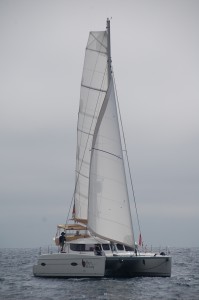
Reefing: Sailing catamarans and, to a lesser extent, trimarans too, require vigilance when it comes to reefing. Since they don’t heel much, almost all additional wind force is converted to load on the rig. That’s where the speed comes from. But since the pressure on the sails quadruples as the wind speed doubles, crews must keep an eye on the weather and reef in good time to keep the boat safe and sailing flat. In fact, a properly reefed cat or tri will sail faster too, in freshening breezes. All manufacturers supply written guidelines denoting apparent wind speeds that require additional reefing.
Safety – Unsinkability There are many aspects to safety where catamarans and trimarans shine. Often overlooked is the safety margin introduced with level sailing (see above). It is much easier to keep crew aboard in rough weather when the boat stays level and is pitching less. Large cockpit spaces keep crew well away from the lifelines as well.
The speed of a multihull is another safety factor, as with decent weather information it’s relatively easy to sail around severe weather systems before they can bear down on you. Should something go horribly awry, and the boat get flipped (VERY rare – see below), the lack of ballast, and additional positive flotation, means that nearly every catamaran and trimaran produced in the last few decades will remain on the surface of the water, rightside up or not, until a rescue can be made. Nearly all cruising cats and tris have a substantial amount of reserve buoyancy, in the form of closed-cell foam, stashed in the nooks and crannies of the boat. Because of this, most could literally be cut into pieces and all pieces would still float. This makes fire your biggest safety concern aboard a cat. And the anchor windlass, but that’s a story for another day.
Can my catamaran or trimaran flip over? This is theoretically possible, and has happened in very rare heavy-weather situations when EVERY vessel is in distress. It takes very high winds, too much sail (see reefing, above), and large breaking waves to flip a modern cruising cat or tri. Multihull sailors find it reassuring to know that their cat or tri will remain on the surface, as a big liferaft and spotting target, while ballasted monohulls caught in the same situation are more likely to end up on the bottom of the sea, with their crew bobbing around (if they are lucky) in an inflatable liferaft.
Motoring Performance/Maneuverability Cruising catamarans and trimarans, with their easily driven hull forms and light weight, enjoy excellent fuel efficiency when compared to monohulls, and track very straight. Cats almost always have twin engines, set many feet apart, which allow for tremendous control in tight situations. In fact, the boat can be spun in place or crabbed sideways without any way on. Try that on a monohull. Prop walk is minimal or nonexistent as well, and the redundancy of a second engine is appreciated should a mechanical issue arise underway. Nearly all trimarans have just one engine, so the differences there are slight.
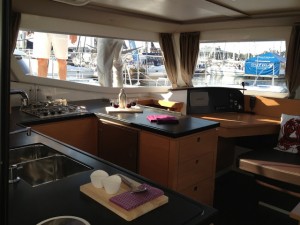
New Catamarans and Trimarans for Sale >>

Start Your Boat Search
Wcm events calendar.
| Dec 2024 | ||||||
| M | T | W | T | F | S | S |
| 25 | 26 | 27 | 28 | 29 | 30 | 1 |
| 2 | 3 | 4 | 5 | 6 | 7 | 8 |
| 9 | 10 | 11 | 12 | 13 | 14 | 15 |
| 16 | 17 | 18 | 19 | 20 | 21 | 22 |
| 23 | 24 | 25 | 26 | 27 | 28 | 29 |
| 30 | 31 | 1 | 2 | 3 | 4 | 5 |

Inside Scoop: WCM News
Email address:

- Your Source for EVERYTHING Multihull!
- Catamarans for Sale
- Contact West Coast Multihulls
- Other Catamarans for Sale
- Sailing in San Diego: Charters & Lessons
- Submit a Testimonial
- Boat Sales: 619.571.3513 Lessons/Charters: 619.365.4326
- Your Source for Catamarans and Trimarans

- Copyright © 2008-2016, West Coast Multihulls
- The Denali theme by Usability Dynamics, Inc.

Catamaran vs. Trimaran: The Differences Explained

As an Amazon Associate, we earn from qualifying purchases. We may also earn commissions if you purchase products from other retailers after clicking on a link from our site.
Most boat lovers know the differences between a catamaran and a monohull. But when it comes to differentiating between a catamaran and a trimaran, things can get tricky because it’s not always clear how much difference the extra hull of a trimaran makes in performance, safety, comfort, and handling. If you’re trying to choose between the two, this is a post you’ll want to read before making a decision.
Besides the number of hulls catamarans(two) and trimarans(three) differ in speed, safety, accommodation, helming, and anchoring. Generally, catamarans are more manageable in a marina and provide better accommodation and comfort. Trimarans, on the other hand, are faster and more fun to helm.
In this post, we’ll cover these differences in greater detail to make it easier for you to choose between a catamaran and a trimaran. First, let’s quickly review each multihull type.
Table of Contents
The Lowdown on Catamarans
Informally dubbed a “cat,” a catamaran is a type of multi-hulled sailing craft with two equal-sized parallel hulls. Cats are typically geometry-stabilized, leveraging their wide beams for stability. That’s unlike monohull boats, which use ballasted keels for stability. Catamarans also have a smaller displacement, lower hull volume, and a much shallower draught ( draft ) than similarly sized monohulls.
The earliest forms of catamarans can be traced way back to the 17th century. They were primarily used for fishing by the Pavaras community in Tamil Nadu, who preferred them over other fishing vessels due to the extra balance and stability provided by the twin hulls. Later on, the British adopted the concept of twin-hulled boats and popularized it worldwide.
Modern catamarans are much more sophisticated than their ancestors. They’ve evolved in terms of the usage versatility, construction, and design, giving rise to two primary configurations:
- Small-Waterplane-Area Twin Hull (SWATH)
- Wave-piercing catamarans
The hulls in a catamaran with a SWATH configuration are typically submerged. That means they’re less affected by ocean waves , which is great for stability when sailing in rough waters. In the recent past, SWATH configurations have been used on research vessels and rescue ships.
Their wave-piercing counterparts, on the other hand, have low-buoyancy bows fitted on the twin hulls. The bows allow the hulls to puncture ocean waves instead of riding over them, making catamarans with such a design faster on rough waters than SWATH cats. In the recent past, wave-piercing cat designs have been used on passenger ferries, military vessels, and yachts.

The Lowdown on Trimarans
Also known as a double-outrigger, a trimaran is a type of multihull boat with one main hull flanked by two smaller “floats” (technically known as outrigger hulls) connected to the larger hull by lateral beams. Such a design makes trimarans incredibly stable, meaning they’re hard to capsize even in the roughest of waters.
The earliest forms of trimarans can be traced to the Austronesian people and are still the most common hull design you’ll find on traditional fishing boats in Maritime Southeast Asia. The majority of today’s double outriggers are yachts meant for racing and recreation, but some warships and ferries have this design.

The Differences Between Catamarans and Trimarans
The most apparent physical distinction between a catamaran and a trimaran is that it has three hulls instead of two.
But other than that, are there other differences between the two vessel types you need to know? Do those differences make one type better than the other?
To find out, let’s compare the two types of multihulls based on the following merits:
Comfort and Accommodation
A Cat’s geometry is ideal for comfort and accommodation. The two load-bearing hulls provide additional habitable space, and you can always create a sizable nacelle between them. Connected to this central living space is a large cockpit, and there are cabins on either end of the hulls. This arrangement is perfect when you’re looking to relax a bit as the party rages on in the saloon because it gives you a bit of privacy.
And with flybridges virtually standard on modern catamarans, you have extra space for entertainment and lounging. The deck area is safe for kids, and the fact that catamarans don’t heel much means that you can do things like cooking at ease. Also worth mentioning is that cats can carry a decent load, meaning you can stock up on food and gear when going away for an extended period.
While trimarans do provide a decent degree of livability, they fall short of catamarans in two regards. First, they heel more than cats, making it difficult to do things like cooking on board. Second, they support much less load than catamarans. To put things into perspective, some 45 feet (14 meters). Cats can carry nearly three tons of payloads, whereas similarly sized trimarans can barely support half that load.
Overall, catamarans provide better, more comfortable accommodation than trimarans.

One of the main concerns when choosing any water vessel is how easy it’ll capsize in the event of a storm. If you’re looking to spend more than just a couple of hours on the water, you want to sail on something that won’t capsize/sink easily because sea conditions can sometimes fluctuate within a short period.
When it comes to safety, three hulls are better than two. Having one main hull and two overhangs on each side makes a trimaran more stable because of two reasons. First, the side overhangs widen the beam of the vessel, which minimizes the chances of the boat flipping over when hit by a large breaking wave from the side. Second, trimarans are typically designed with the weight centered on the main hull, further enhancing stability.
Multihull stability is a complex topic and should be understood in detail if you want to stay safe at sea!
- Why do catamarans capsize?
On the rare occasion that a trimaran flips over, it’ll stay afloat. That means if the worst happens, a capsized trimaran will turn into a potential life-saving raft that’s easier to spot from a helicopter. That’s because almost all trimarans designed in the last decade or so come with closed-cell foam distributed throughout the various parts of the boat to provide reserve buoyancy.
Thanks to this kind of construction, you could cut most trimarans into pieces, and each would still stay afloat.
While catamarans are typically more stable than monohulls, they’re no match for a trimaran in this regard. Hypothetically speaking, it would be easier to tip over a catamaran than a trimaran if both boat types were subjected to equal magnitude storms. That, however, doesn’t mean that catamarans aren’t safe. They’re still harder to flip over than monohulls and will stay afloat when that happens because they come with the same closed-cell foam found in a trimaran.
While on the subject of safety, it’s worth mentioning that trimarans require less vigilance as far as reefing is concerned . Since catamarans heel less, most of the extra wind force translates to more “push” on the rig, increasing speed. But because the pressure exerted on the sail nearly quadruples when the wind speed doubles, you need to be extremely careful when timing your reef to keep a cat sailing flat.
The same goes for reefing a trimaran, except that the slight heel gives you more room for error in terms of the timing.

Most people who’ve ever steered both a trimaran and catamaran will agree that the former is more fun to sail. Most light trimarans, especially tiller-steered ones, have a terrific response to the helm. They have a slight heel that somewhat feels like a monohull, but the angle is a bit limited.
A catamaran is stable, but it doesn’t heel. While heeling may be frowned upon by people who prioritize comfort and accommodation in a boat, it’s one of the most exciting parts of sailing. With three hulls to ensure stability, trimarans combine the heel of a monohull with a catamaran’s stability to deliver the best sailing elements of monohulls and multihulls in a single package.
Considering that trimarans are more stable, you may be better off with one if you’re looking to have some fun as you perfect your helming skills.
Speed is another area where trimarans outperform their twin-hulled counterparts. Typically lighter than catamarans, trimarans need less sail distance to hit double-digit speed averages. A trimaran can maintain a formidable course up-wind when fitted with centerboards/daggerboards (as is often the case for modern models).
While a catamaran is still faster than a monohull of identical size, it falls short of the trimaran in terms of sheer speed. Understand that this doesn’t make catamarans slow boats; it’s just that tris are typically designed with more emphasis on performance.
Why are Trimarans Faster Than Catamarans?
Trimarans are easier to anchor than catamarans because they allow you to keep the ground tackle in and deploy it from the main hull.
However, catamarans are more maneuverable and manageable in a marina. They also handle docking lines more conveniently.
Catamarans vs. Trimaran: The Verdict
In summary, here’s what the differences between a cat and tri mean for anyone trying to choose between the two: A catamaran is a better choice if you’re looking to accommodate many people on board for something like a party because it’s more spacious and comfortable than a trimaran. On the other hand, a trimaran is an ideal choice for speed junkies and individuals looking to push their sailing skills to the next level on every stable platform.
Hopefully, that has cleared the air and made it easier for you to pick a more suitable option for your sailing needs.
- ResearchGate: A comparison of the motions of trimarans, catamarans and monohulls | Request PDF
- Why are trimarans faster than catamarans?
Owner of CatamaranFreedom.com. A minimalist that has lived in a caravan in Sweden, 35ft Monohull in the Bahamas, and right now in his self-built Van. He just started the next adventure, to circumnavigate the world on a Catamaran!
Leave a Reply Cancel reply
Your email address will not be published. Required fields are marked *
Save my name and email in this browser for the next time I comment.
Recent Posts
Must-Have Boat Gear for Catamaran Sailors!
Sailing is probably the most gear-intensive activity I've ever done; there are so many decisions to be made about what gear to buy now, for tomorrow, and what to definitely never buy. The gear on...
6 Best Trailerable Trimarans For Bluewater and Coastal Sailing
Having a boat costs a lot of money, even when you are not using it, marina fees, etc. And once it is in the water most sailors never go very far from their "home marina" and sailing will be somewhat...
Catamaran Vs Trimaran

As boatbuilders make faster and more luxurious multi-hulls for cruising and racing, it is time to settle the debate: Catamarans vs. Trimarans.
Catamarans and trimarans have distinct characteristics regarding comfort, sailing performance, safety, and personal preference. The dual- or tri-hull designs both confer significant advantages over traditional monohulls and each fill an amazing niche in the sailing world.
Though both are based on traditional Austronesian outrigger canoes, the dual-hulled catamarans and tri-hulled trimarans have distinct design goals that make them ideal for very different purposes, and it is important to take into account your goals when trying to decide which to sail! We’re going to discuss both types as they rate across performance, safety, comfort, and possible uses. There is no one solution to this age-old problem, but we can help you understand which design is best for you!
From boatbuilder releases to the history of their development, it is important to access lots of sources when trying to make this decision. As a performance sailor, my heart is always in the speed and upwind abilities of the trimaran, but modern catamarans are dynamic and incredibly comfortable. Still, in my opinion, anything that gets you on the water is a great boat, so let’s find the right one for you!
Table of contents
Sailing Performance and Safety
While most traditional boats over 20 feet are monohulled keelboats, there are major limitations to the type of sailing you can do with a monohull. First of all, monohulls depend on their keel to keep them upright, which is effective, but the force of the wind almost always causes the boat to heel to leeward by angles of up to 25° under reasonable cruising conditions, which can be quite uncomfortable for the crew! This design, which relies on giant lead ballast in a deep-set keel, is vulnerable to capsizes and, in drastic cases, sinking.
Additionally, the single-hull only provides so much volume for accommodation and storage, while the more horizontal layout of the multi-hulls can increase cockpit and cabin sizes substantially. Beyond that, both types of multi-hull can experience higher speeds at a given hull length than monohulls.
So how do cats and tris compare to each other? Well,
Catamarans: Stability and Ease
With their dual ‘pontoons,’ Catamarans make use of their floats to always remain on a flat and consistent angle of heel, rarely sailing under more than 10° of heel. This distribution of floatation also makes it nigh on impossible for them to capsize, though the distance between the hulls can make it a problem in the rare cases that they do flip. They do suffer a bit from not having any wetted surface underneath the center of effort, causing them to slide sideways while sailing upwind and making it difficult for them to beat tight angles to the breeze. While they make up for this with speed on the reach and downwind, catamarans are an inferior option for trying to make progress upwind in heavy sea and wind conditions.
These tradeoffs do come with some advantages. Unlike monohulls, catamarans have very shallow drafts, allowing cruisers to sail close to shore without concern, and their common dual-motor design allows them to maneuver incredibly well in tight spaces with a built-in backup for single-engine failure. They heel minimally because of the horizontal distribution of weight, and this means that they are incredibly stable and comfortable while underway or at anchor. In addition, their sail plans and maneuverability characteristics do make them easier to sail with a smaller crew, requiring fewer highly experienced sailors in your party.
Trimaran: Speed and Safety
While traditionalists have finally come around on the aesthetics of the dual-hulled catamaran, the tri-hulled lines of trimarans can still be a bit of a shock to viewers. They combine the vertical stability and upwind capabilities of a monohull with the speed and lateral stability of a catamaran.
When it comes to performance sailing, modern trimarans are well ahead of any other hull design. Due to the relationship between speed and the ‘waterline length’ of a boat, i.e. that more hull length in the water leads to higher speeds, the third hull actually makes trimarans drastically faster than any other hull shape at a given length. Most current speed records, including those for circumnavigation, instantaneous velocity, and single-day distance, are held by Trimarans. In competition, the 2013 America’s Cup is a perfect example of the superiority of Trimarans over Catamarans in terms of speed, as the challenging Trimaran from Golden Gate Yacht Club handily beat the defending Spanish Catamaran in a best-of-three series. With their signature central hull, they can make better upwind progress without drifting and often heel even less than contemporary catamarans.
Further, trimarans far outclass both catamarans and monohulls in terms of safety. The central hull gives the trimaran that signature central righting moment from monohulls, while its winged pontoons provide it the lateral balance that makes catamarans so safe themselves. Combined, this gives a modern trimaran a righting moment of 27°, which is almost impossible to reach in any breeze condition because of the pontoons. For a comparison, modern cats can only maintain 12° of heel before flipping, which is not entirely uncommon in heavy seas.
Therefore, in a purely technical sense, trimarans are safer, speedier, and more rewarding. Still, to reap these benefits you often need to be a little more prepared to engage with the more advanced aspects of sailing, and the tri-hull design does make some sacrifices in other areas.
Though performance is an important metric for all sailboats, every added knot of speed or degree of heel comes at a price of comfort, and it is here that we need to consider the full implications of that cost for both cats and tris.
Catamaran: The Ideal Platform
When it comes to comfort, space, and luxury, it is hard to bet against the catamaran. Because of the geometry of the dual deep hulls and built-up central platform, catamarans offer the ideal vessel for a large crew, a party yacht, or a comfortable getaway vessel. They heel minimally, are highly stable at anchor, and the central platform can be carefully built to maximize the area between the wings. Most catamarans can offer the living space and horizontal area of much larger monohulls, making it the ideal choice for a pleasure cruise.
Trimaran: The Cost of Speed
For all their advantages in terms of performance, the hardware required for the central hull subtracts substantially from the accommodations that are available for a cat of the same size. New trimarans, like the Neel 51 which made waves back in 2017, are pushing back against this perceived comfort gap, the large central hull with the two performance-oriented wings does make it harder for tris to haul the same amount of weight and provide comparable space as most cats.
Preferences
The beauty of modern sailboats is that design advances in both catamarans and trimarans make it possible for all sailors to find the exact right boat for them. Speed demons who want to sail tight to the wind and feel that rush may find themselves enticed by the capabilities of the newest Trimarans, while cruisers looking to get the biggest space for the length are still thrilled by how fast and stable modern Catamarans are off the breeze. While no one would complain about being invited to a cruise on a new Trimaran, you can certainly fit more of your friends in the spacious decks of a Cat.
Both multi-hull styles excel at maneuvering in small spaces and shallow waters, perfect for island hopping or inland sailing. Their wide platforms, which can run a slightly higher cost at marinas than comparable monohulls, enable stability without sacrificing performance. Both are regarded as incredibly safe in nearly all conditions, though Trimarans do have the slight edge in truly nasty weather.
In the end, it all comes down to how you want to sail and what is going to make a good trip successful! For those looking for a leisurely cruise with a minimum of work and a maximum of space, find the most spacious catamaran you can, and don’t worry about missing out on speed as you’ll more than hold your own off the breeze. If you’re excited to go fast no matter what direction the wind is coming from, with the knowledge that you’re nigh on unsinkable, a performance trimaran is the way to go!
Happy Sailing!
Related Articles
Gabriel Hannon
I have been sailing since I was 7 years old. Since then I've been a US sailing certified instructor for over 8 years, raced at every level of one-design and college sailing in fleet, team, and match racing, and love sharing my knowledge of sailing with others!
by this author
Learn About Sailboats
Most Recent

Dufour Sailboats Guide & Common Problems
Daniel Wade
October 16, 2024

What Does "Sailing By The Lee" Mean?
October 3, 2023
Important Legal Info
Lifeofsailing.com is a participant in the Amazon Services LLC Associates Program, an affiliate advertising program designed to provide a means for sites to earn advertising fees by advertising and linking to Amazon. This site also participates in other affiliate programs and is compensated for referring traffic and business to these companies.
Similar Posts

The Best Sailing Schools And Programs: Reviews & Ratings
September 26, 2023

Affordable Sailboats You Can Build at Home
September 24, 2024

Best Small Sailboat Ornaments
September 12, 2023
Popular Posts

Best Liveaboard Catamaran Sailboats
December 28, 2023

Can a Novice Sail Around the World?
Elizabeth O'Malley
June 15, 2022

4 Best Electric Outboard Motors

How Long Did It Take The Vikings To Sail To England?

10 Best Sailboat Brands (And Why)
December 20, 2023

7 Best Places To Liveaboard A Sailboat
- Yachting for beginners
- Owning a yacht
- Motor Yachts
- Sailing Yacht
- Indian Ocean
- Mediterranean
- Buying or Selling a Yacht
- Yachting Events
- FAQ – Luxury Yacht Charter
- FAQ – Buying a Yacht
- FAQ – Sell your Yacht
- How Much Does It Cost To Charter A Luxury Yacht?
- All our Blog Post & News

Trimaran vs. Catamaran: What are the Differences?

Experience the thrill of sailing on a multihull – a boat with two or three hulls. Discover the unique features of the trimaran and the catamaran , and how they differ in performance and comfort. Want speed and excitement? Take the helm of a trimaran. Prefer a leisurely cruise? Relax on a catamaran. Don’t miss out on this exciting article uncovering the secrets of multihull sailing.
How to recognize a trimaran from a catamaran?
First up, the catamaran. Simple, sleek, and stylish, this craft boasts not one, but two identical hulls – making it a twin amongst ships. Its minimalist design is a thing of beauty, and it might just be the perfect float for solo explorers or couples seeking a romantic ocean adventure.
On the other hand, the trimaran is a multihull masterclass in innovation. With a total of three hulls, including two small outriggers, this vessel’s design is unlike anything you’ve seen before. In fact, some have compared it to a spaceship, and we can see why! The trimaran’s unique layout and engineering wizardry make it a worthy addition to any seafarer’s fleet.
So, whether you’re a catamaran connoisseur or a trimaran trailblazer, there’s no denying that these vessels are truly remarkable. Just don’t ask us to choose a favourite!

What are the trimaran main characteristics?

A trimaran’s three hulls are like the training wheels on a bicycle, making it incredibly stable even in choppy waters. These recreational boats are a sailor’s dream, offering a smooth ride and exceptional comfort. And when it comes to safety, trimarans are virtually unsinkable due to their triple-hull design – even the roughest storms won’t capsize them! Although compromising some sailing capacity, the security and stability of a trimaran are unmatched.
All about Neel trimaran here
What are the catamaran main characteristics?

Discover the one-of-a-kind world of catamarans – versatile vessels affectionately nicknamed “cats”. Offering an exciting and luxurious sailing experience, these boats come in a range of sizes, from cozy two-person cabins to expansive group accommodation for up to 20. Some catamarans are budget-friendly options perfect for families, while others provide the ultimate indulgence and can transport you to some of the most coveted destinations in the Caribbean and Mediterranean. With their roomy interiors and stable design, catamarans are perfect for exploring calm sea gulfs, lagoons or shallow waters.
What is the (true) cost of chartering the yacht you've seen? 💰⛵
The advertised prices of all charter companies do not include APA, VAT & other variable costs.
Use our calculator to get a 100% FREE estimate of the REAL total cost of your next yacht charter! ⬇
All our catamarans & trimarans for charter here
Trimaran vs. Catamaran: which one has the largest surface area?

Catarmarans surface area is known to be spacious
Catamarans have filled the world’s oceans in recent years with more huge and luxury versions, including sailing catamarans like the Lagoon Seventy 7, Fountaine Pajot’s Allegria 67, and motor catamarans like the Sunreef Power 70. The biggest catamaran known is Hemisphere, and you may want to have a look at Douce France available for charter with WI.
Catamarans are well-known for their large living quarters, which are divided between the two hulls and the central platform.
Trimarans surface area are constantly improving
Among some of the cruising, habitable trimarans, the DragonFly boasts a unique Swing Wing system and a plush interior, while the Vietnamese-made Rapido Trimaran is the brainchild of the esteemed Morrelli & Melvin design house. But what really sets the Naval NEEL shipyard trimarans apart is the incredible “Cockloon” living area above the central hull – it’s like staying in a floating hotel! With cabins located solely on the floats, the central kitchen, panoramic saloon, and lounging areas are all linked together for an unbeatable sense of space and luxury. And don’t forget the expansive flybridge, too!
Read also : The yacht charter experience ladder
Trimaran vs. Catamaran: Stability and Performance

The Trimaran stability made it famous
With three hulls, including one main and two overhanging, a trimaran is built for stability even in the roughest waters. In fact, it’s nearly impossible for a trimaran to capsize, making it a safer option for the adventurous seafarer. And if by some chance or circumstance the boat does flip, fear not – it’ll stay afloat! The only downside? The trimaran provides both the comfort of a monohull and the safety of a multihull, but hey, no boat is perfect. Did we mention it’s also one of the fastest boats out there? Sounds like a win-win to us.
The Catamaran performances aren’t as versatile as trimaran
Catamarans are incredible vessels that offer not only a smooth sailing experience, but also a comfortable ride. Ranging in size from cozy cabins for two to massive ships that can fit 20, catamarans are top-notch for stability. However, they aren’t particularly cut out for rough seas, preferring calm waters like tranquil gulfs and shallow lagoons. Keep in mind that while they may not excel in upwind sailing and lack the heeling abilities of other boats, catamarans will still take you on a sailing adventure like no other.
Trimaran vs. Catamaran: Distinct Sailing Experiences

Sailboats rely on wind speed to move forward, but stability is crucial to avoid capsizing. Monohulls have a keel underneath to prevent this, making them more durable in heavy winds. Meanwhile, multihulls such as catamarans offer greater stability with their floats, resulting in a smoother ride even in rough seas. However, trimarans are more similar to monohulls and may tip more, offering advantages in rougher waters but less comfort on calm days. Overall, multihulls have an edge in stability compared to their monohull counterparts.
Trimaran vs. Catamaran: Safety
Trimarans are very safe boats.
You might be surprised to find out that Trimarans are extremely safe; in fact, many trimarans, are almost unsinkable. They have a core made up of foam, and the materials’ buoyancy is extremely high in comparison to the boat’s displacement. Trimarans are safe because of their breadth. The trimaran is the safest of the multihulls because of its three-hulled design, weight centering, and complete anti-drift scheme.
Moreover, even if the trimaran were to overturn, the structure would keep it from plummeting into the water, making it an extremely safe boat.
Catamarans safety is still very good
Catamarans are a safe way to travel the ocean. Offshore, catamarans are often far safer than monohulls of similar size. Enhanced resilience, speed, steadiness, and motion ease due to a lack of ballast all contribute to safety.
A large modern catamaran has an outstanding resilience and roll inertia. The mix of these factors makes invasion or capsizing extremely unlikely. When a 20-foot wave hits a catarmaran’s beam, the boat will just surf sideways.
Trimaran vs. Catamaran: Racing

Catamarans are very fast downwind
Catamarans are recognized for their velocity, and some of them are capable of breaking world sailing records. Catamarans may travel at a pace of 15 to 30 mph, with the best reaching speeds of well over 60 knots.
Cruising catamarans may reach high speeds of 15 knots, or 17.3 mph, on average (27.84 kph). In the right wind conditions; however, some outstanding racing catamarans can reach a pace of up to 30 knots.
On downwind runs, reaches, and broad reaches, catamarans are typically quicker than trimarans. Sailing a catamaran is less exhausting than sailing a trimaran. Sailing flat has a number of benefits. Carrying tanks and other diving equipment is significantly simpler on a cat if you are a SCUBA diver.
Catamarans are lighter than trimarans because they do not require a heavy keel. This, along with the fact that their sails are placed equivalent to the wind, allows them to sail quicker than trimarans, particularly on a run or broad reach.
Trimarans are the usual racing winner
Trimarans are frequently preferred in racing these days, especially in the previous decade or so.
For long offshore races, racing trimarans’ speed and safety qualities have significant benefits. Even in severe seas, they can be pushed harder and are more forgiving than other racing catamarans. These are the primary reasons why trimarans have become so popular in recent multihull competitions. Trimarans, for example, have won the Jules Verne Trophy every year since 2010.
Trimarans can often increase their monohull sailing speed on almost every point of sail while cruising catamarans are usually 25-30 percent faster than a sailing monohull of the same length. Of course, when the boats are filled for cruising, these comparisons vary drastically.
A trimaran is more suited to sail upwind than a catamaran, which is more vulnerable to drifting. Trimarans are; therefore, quicker than catamarans, and this benefit is especially noticeable when cruising against the wind due to the weight centering in the middle hull, which lowers pitching.
The third hull really makes trimarans considerably quicker than any other hull form at a given extent based on the relation between a boat’s waterline length and speed i.e. that more hull distance in the water leads to higher speeds.
Which is Better: A Trimaran or a Catamaran?

If you want to spend less time on deck, a catamaran is a great option. Catamarans are also ideal for hosting gatherings and parties while maintaining their stability on the water.
A trimaran is a more ideal boat for you if you want to develop your sailing talents on something more difficult. Moreover, if you’re a speed demon, keep an eye out for the fastest trimaran boats and pick the one that best meets your needs.
While picking between a catamaran and a trimaran appears simple on paper, it becomes more challenging when you see them in front of you. Check out our page for more details in order to make a more informed decision.
Read also : YACHT INSURANCE: THE DEFINITIVE OWNER’S GUIDE

Experience the ultimate Caribbean holiday aboard l’Octant a Neel 51 trimaran.
Don’t miss out on this incredible opportunity from $14,500 per week.

Gunboat 72V “Wonderful”: Our Review of the (Very) Fast Catamaran
The yacht refit guide: tips and realities, you might also like.

How to Predict Cyclones: Key Signs and Global Hotspots for Storm Activity

5 Price Levels for Yacht Charters: Which Experience Can You Afford?

Windward Yachts Launches WhatsApp Channel for Latest Updates
- Yachts for Sale
- Sales Report 2024
- FAQ – Luxury Crewed Yacht Charters
- FAQ – Bareboat charters
- FAQ – Sell your Boat
- FAQ – Buying a Yacht
- How Much does it Cost to Charter a Luxury Yacht?
- All Blog Posts and News
- Yachting for beginners
- Indian Ocean
- Mediterranean
- Sales & New build
- Motor Yacht
- Event & News

Trimaran vs Catamaran: What are the Differences?
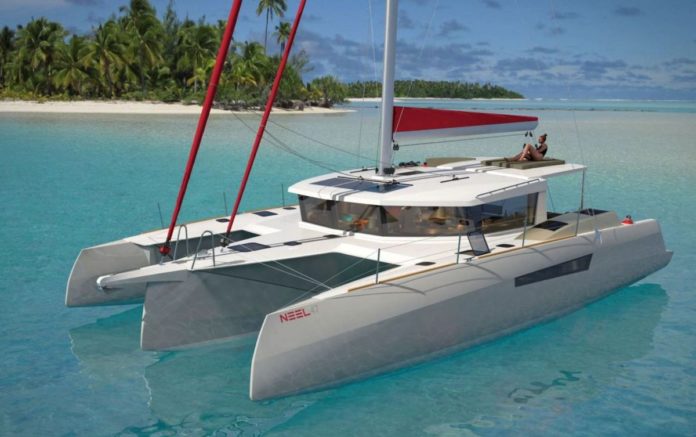
The debate between trimarans and catamarans has been raging for years, with no clear victor in sight. Despite their long-standing popularity as cruising vessels, trimarans have seen a resurgence recently – but what sets them apart from catamarans? The subtle differences lie mainly within the hulls; while monohulls are distinguishable several yards away, distilling one multihull from another requires closer examination of characteristics such as living space size accommodations, seaworthiness ratings , speeds achieved on test runs.
With these variables to consider – along with personal preference – deciding which vessel is right may be difficult indeed!
The summary of the battle between Trimaran and Catamaran
| Criteria | ||
|---|---|---|
| Three hulls for enhanced stability and performance. | Two hulls providing spacious living areas. | |
| Superior speed and efficiency, especially in headwinds. | Generally slower than trimarans but stable in calm conditions. | |
| Excellent stability with a righting moment of 27°. | Good stability but lower righting moment of 12°. | |
| Less likely to capsize, with buoyancy tanks for added security. | Stable but more prone to capsizing in rough seas compared to trimarans. | |
| Offers comparable living space but typically less than catamarans. | Known for luxurious and spacious interiors, ideal for family cruising. | |
| Best for racing and performance sailing; suitable for adventurous sailors. | Ideal for leisurely cruising and family outings; comfortable for long trips. | |
| Generally more expensive due to advanced design and materials. | Prices vary widely; often more affordable options available. | |
| Gaining traction in racing and adventure sailing markets | Continues to be popular for recreational cruising and luxury markets. |
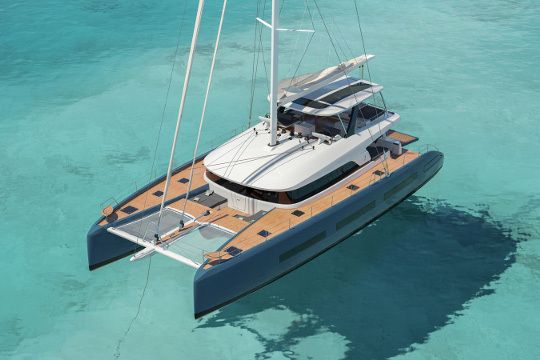
Performance and Stability: two distinct sailing experiences
The stability of a catamaran vs a trimaran.
When sailing on a monohull in strong winds, the boat can potentially capsize due to its single hull and lack of floatation. On the other hand, multihulls such as catamarans are more buoyant because they have two floats that help prevent immersion; however it still may be uncomfortable when navigating heavy seas. For the most optimal sail experience with great stability even through rough waters–pleasure trimarans provide an ideal combination! Three connected hubs act like small wheels over rippling waves while providing excellent comfort aboard no matter what conditions lie ahead!
Read also : Trimaran our ultimate guide
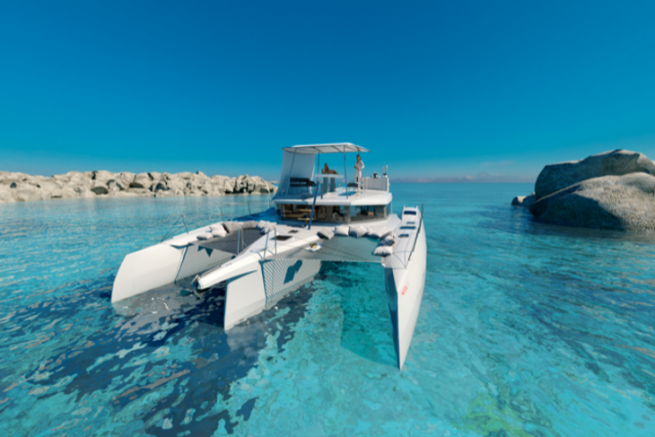
The wind and its influence on the performance of multihulls
In sailing, trimarans outperform catamarans in a headwind situation. Their unique hull design features both daggerboards and central weight focus which allows them to counteract the thrust of wind better so as to stay on course rather than drifting away like their counterparts do. This subtle difference makes significantly more efficient vessels resulting in overall faster speeds when heading into the wind – making trimiras an ideal choice for less experienced sailors seeking reliable performance!

Looking beyond traditional catamaran styles?
Trimarans such as DragonFly boast amazing features thanks to its “Swing Wing” system while Rapido Trimaran offers “an experience like nothing else”—thanks in part due to Morrelli & Melvin architect firm constructing this Vietnam built masterpiece!
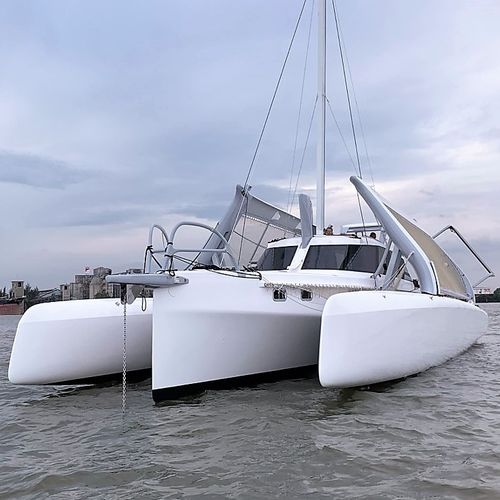
For those seeking a luxurious floating lifestyle, the trimarans from shipyard NEEL are second to none! These vessels feature ‘Cockloon®’ areas which seamlessly connect saloons and cockpits – providing uninterrupted living spaces with breathtaking panoramic views. Alongside this is an expansive flybridge offering extra room along with comfortable cabins nestled within their own designated floats for ultimate relaxation. You could say that these modern marvels of engineering provide all you need in one single package – now it’s just down to choosing your destination!
Looking for the perfect blend of stability, comfort and interior space? Look no further than the NEEL 65 – a unique trimaran that boasts roomy cabins thanks to its enlarged volume. Not only does it offer more living area compared with typical catamarans – but also features an optimally aligned central hull which provides extra safety at anchor! So if you’ve been in two minds between these nautical vessels; perhaps this could sway your decision once and for all…
Trimaran vs catamaran safety: the width of trimarans makes them safer
The trimaran stands out as the most secure of its multihull contemporaries. Its superior design consisting of three hulls, effective anti-drift strategies and centre-mounted weights combine to provide it with a groundbreaking 27° righting moment – allowing for excellent stability in even gusty weather or choppy waters. In comparison, catamarans offer just 12° degrees protection against capsize – meaning that the trustworthiness offered by a trimaran is hard to match! Further punctuating this remarkable level of security are features such as buoyancy tanks which ensure that if capsizing does occur, sinking will not be an issue: making trimarans perfect vessels for sailing’s safety conscious connoisseurs.
Racing trimarans
In the last decade, trimarans have surged in popularity for racing purposes due to their enhanced speed and safety capabilities. Their stability on rough seas allows them to be pushed further than catamarans can go without sacrificing control of the vessel; this is why most multihull races since 2010 have been captured by a trimaran! The Jules Verne Trophy has not seen any different – all winners since its start in 2010 are proud owners of these three-hulled vessels.
How to make the right choice between a monohull, a catamaran, and a trimaran?
No matter what sailing adventure you have in mind and the destination, it is essential to select a vessel that will fulfill your dreams while meeting all of your demands. Make sure to pick wisely!
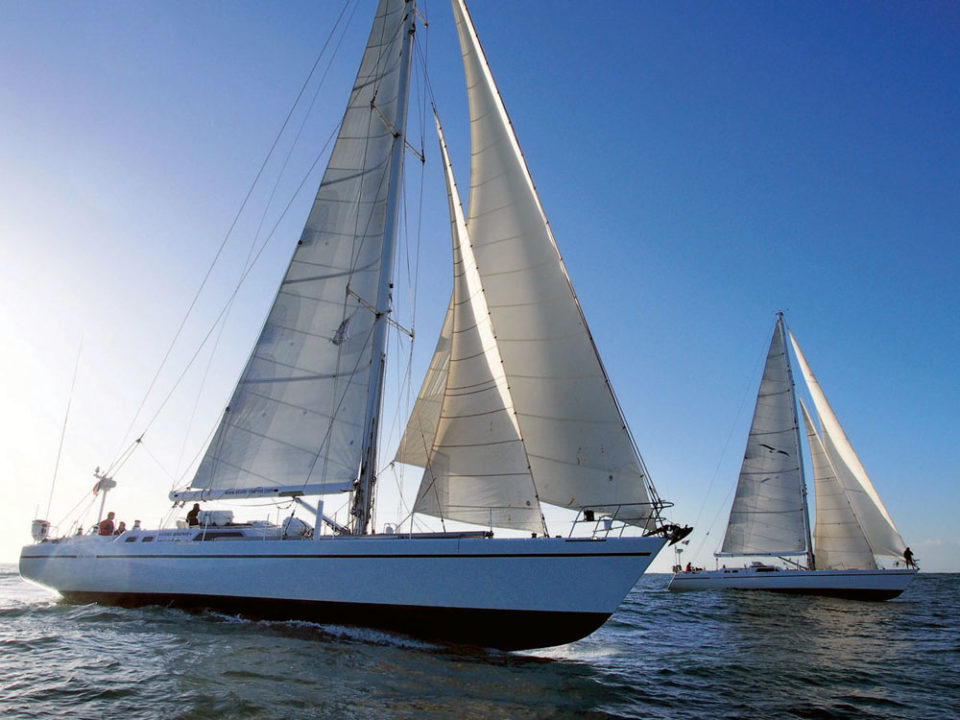
Choose a monohull sailboat if you like sailing!
Nothing quite compares to the feel and freedom of a sailing adventure aboard your own monohull sailboat. With its large, retractable keel, you can explore shallow waters where other boats may not venture while taking in stunning vistas from beyond the coastline. Enjoy an unforgettable experience with every rustle of wind across your sails!
Read also : Monohull vs Catamaran, which one to choose?
Pick a catamaran if you like volume and calm seas
TThe catamaran is perfect for adventurers seeking the tranquility of sailing with family and friends. With a spacious interior, multiple cabins equipped with bathrooms, and an enviable amount of storage capacity above 12m in length – it’s easy to see why these boats have become so popular! However when navigating more turbulent seas keep in mind that their windward grip may make maneuvering tricky; but Catana’s boat selection has you covered thanks to its range featuring daggerboards allowing captains ultimate control over any situation.
Pick a trimaran for a good combination of volume and performances
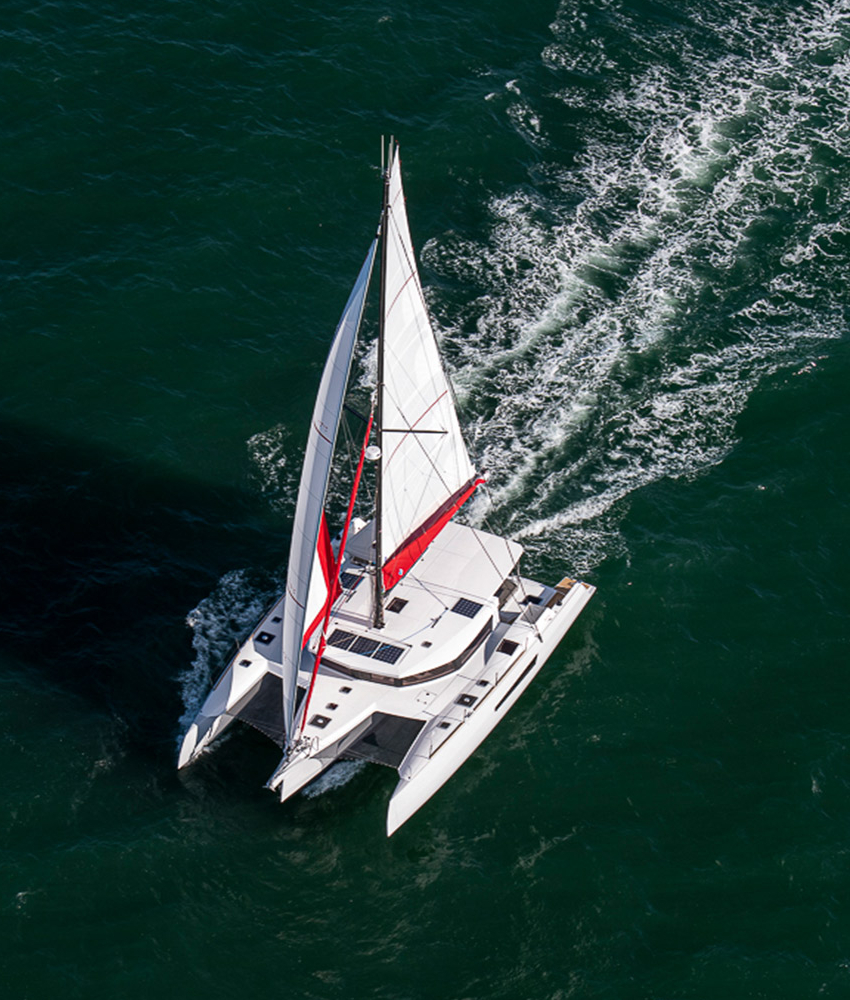
For those looking for a sailing experience like no other, trimarans are the perfect answer. They offer lightning-fast speeds and truly exhilarating performances on open waters – all while providing plenty of roomy living space comparable to catamarans of similar size! Whether you’re attempting an adventurous transatlantic crossing or simply want to enjoy some pleasant cruising around the world, selecting a recreational trimaran could be your best bet.
Enjoy cruising on the NEEL 51 , a unique charter yacht that offers plenty of space without sacrificing performance. This trimaran-inspired vessel is perfect for travelers who want to explore new destinations quickly and safely — with speeds twice as high as other options!
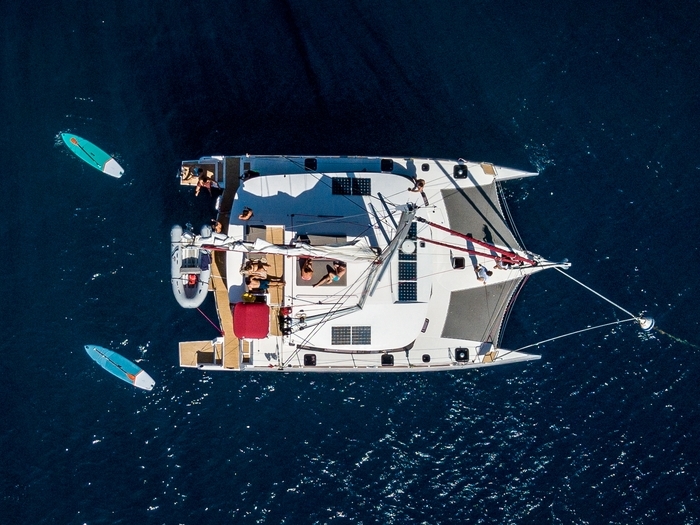
Read more: LEEN 72′: The Future of Hybrid Trimarans is Here .
After looking into the differences between catamarans and trimarans, we can conclude that they each offer distinct sailing experiences. Catamaran sails offer a sense of comfort and stability for extended cruising trips and luxurious living spaces, while trimarans are better on performance, safety – due to the increased width of their hulls – and speed when racing. Ultimately though, it all comes down to personal preference when it comes to choosing between a monohull, a catamaran or a trimaran. If you want to gain speed and enjoy the thrill of racing, then a trimaran may be your best option; however if you prefer comfort and more space while cruising, then a catamaran may be more suited for your needs. Whichever you ultimately decide to purchase, just make sure that it fits your specific circumstances and requirements.
If you’re looking to buy a trimaran, don’t miss this opportunity to learn about the latest models and their features. Get the inside scoop on what to look for in a trimaran and what you can expect to pay. Find out how to choose the right size and style to meet your needs and budget. And if you’re looking to sell your trimaran, don’t miss this chance to connect with a global audience of interested buyers. Showcase your boat’s unique features and benefits and reach a wider audience of potential buyers.
So don’t wait any longer! Take advantage of this opportunity to learn more about buying or selling trimarans. Whether you’re a seasoned sailor or just starting out, this is your chance to dive deeper into this exciting world of boat ownership. Click the link below to get started today!
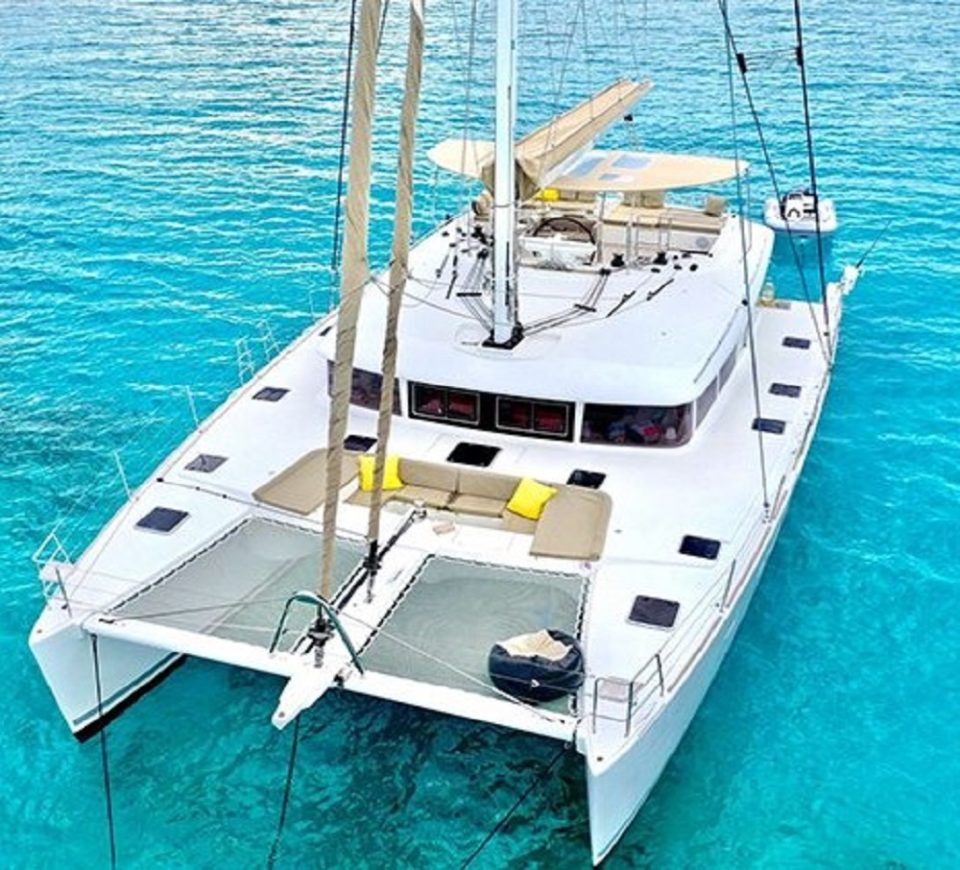
Whether you’re a fan of stability or speed, there’s one boat that can give you both – the trimaran vs catamaran. Catamarans provide plenty of living space and comfort in calm waters but struggle with choppy seas, while modern trimarans deliver excellent performance even on rough days yet still offer good room to relax onboard. But if vintage sailing is more your style opt for an older-style tri since it won’t be equipped with as much creature comforts!
Catamarans and trimarans are two types of watercraft that rapidly cut through the waves, but when it comes to speed one stands out above the rest. Trimarans have gained a reputation for being fast enough to take on any other vessel in a race – making them an excellent choice for anyone looking to shave precious seconds off their time!
When it comes to safety on the sea, two of the most popular vessels are Trimarans and Catamarans. Thanks to their side hulls, trimarans offer a much greater heeling angle compared with catamarans – meaning they’re less likely to capsize or sink in rough waters. However don’t let that put you off taking out a catamaran – while not as secure as its three-hulled cousin – these craft still provide plenty of stability for your seafaring adventure!
If you’re looking for an affordable seafaring vessel, the choice between a catamaran or trimaran can be daunting. With numerous factors that impact cost – from age and length to comfort levels and desirability – it’s often hard to tell which of these two sailing vessels will fit your budget best. But with some research, you’ll find just the right combination of affordability and quality suited perfectly to your needs!
RELATED ARTICLES MORE FROM AUTHOR
Biggest yachts you can run without a crew, best power catamarans manufacturers & models: our selection, 5 new boats under 50 feet that are ideal for first time buyers.
- Testimonials
- Privacy Policy

IMAGES
COMMENTS
The most noticeable thing about sailing a catamaran or trimaran vs a traditional monohull is the lack of heeling. Even when powered up, a cat or tri will rarely heel more than 5-10 degrees before it’s time to reef.
Catamarans vs. Trimaran: The Verdict In summary, here’s what the differences between a cat and tri mean for anyone trying to choose between the two: A catamaran is a better choice if you’re looking to accommodate many people on board for something like a party because it’s more spacious and comfortable than a trimaran.
Catamarans and trimarans have distinct characteristics regarding comfort, sailing performance, safety, and personal preference. The dual- or tri-hull designs both confer significant advantages over traditional monohulls and each fill an amazing niche in the sailing world.
Oct 31, 2020 · The final answer will depend on a number of factors, including: experience, crew, budget and the destination. There are pros and cons to both catamarans and monohulls so here’s what to consider and how to maneuver them both like a pro. Your Experience And Familiarity. Managing a catamaran is not like driving a monohull in both good and bad ways.
Oct 9, 2023 · Trimaran vs. Catamaran: Safety Trimarans are very safe boats. You might be surprised to find out that Trimarans are extremely safe; in fact, many trimarans, are almost unsinkable. They have a core made up of foam, and the materials’ buoyancy is extremely high in comparison to the boat’s displacement. Trimarans are safe because of their breadth.
Nov 30, 2023 · Catamaran VS Trimaran Performance and Stability: two distinct sailing experiences The stability of a catamaran vs a trimaran. When sailing on a monohull in strong winds, the boat can potentially capsize due to its single hull and lack of floatation.